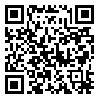Volume 8, Issue 4 (10-2020)
J Diabetes Nurs 2020, 8(4): 1223-1236 |
Back to browse issues page
Download citation:
BibTeX | RIS | EndNote | Medlars | ProCite | Reference Manager | RefWorks
Send citation to:



BibTeX | RIS | EndNote | Medlars | ProCite | Reference Manager | RefWorks
Send citation to:
Davoodi M, Dindamal B, Dargahi H, Faraji Khiavi F. Barriers and Incentives for Patients with Type II Diabetic Referring to Healthcare Centers: A Qualitative Study. J Diabetes Nurs 2020; 8 (4) :1223-1236
URL: http://jdn.zbmu.ac.ir/article-1-447-en.html
URL: http://jdn.zbmu.ac.ir/article-1-447-en.html
school of health , faraji-f@ajums.ac.ir
Abstract: (3405 Views)
Introduction: One of the behavioral problems among diabetic patients in Ahvaz is found to be their infrequent referral to diabetes units. Therefore, this qualitative research aimed to identify barriers and incentives for patients with type II diabetes referring to healthcare centers.
Materials and Methods: The present qualitative content analysis research was conducted in Ahvaz in 2017. The population of this study consisted of 69 patients with type II diabetes referring to diabetes units of healthcare centers in Ahvaz. The necessary data were collected through performing interviews until and was continued until data saturation was achieved. All interviews were transcribed verbatim and finally analyzed by the researchers.
Results: The barriers and incentives for type 2 diabetic patients to refer to diabetes units were each divided into two categories of individual and systemic. Individual barriers included two categories of economic barriers (3 codes) and occupation factors (1 code), and systemic barriers consisted of four categories, namely information barriers (2 codes), lack of facilities, equipment, and expertise required by patients (3 codes), access limitations (1 code), and long waiting queues (1 code). Individual incentives included one category of patients' awareness (1 code) and systematic incentives consisted of 2 categories, namely financial factors (1 code) and proper educational and public relations (2 codes).
Conclusion: It seems that the use of e-learning and distance learning can greatly contribute to remove individual barriers and satisfy the patients' needs. Moreover, in the systemic barriers section, the patients' referral problems can be solved by the cooperation of different organs with each other and the increase of inter-departmental coordination.
Materials and Methods: The present qualitative content analysis research was conducted in Ahvaz in 2017. The population of this study consisted of 69 patients with type II diabetes referring to diabetes units of healthcare centers in Ahvaz. The necessary data were collected through performing interviews until and was continued until data saturation was achieved. All interviews were transcribed verbatim and finally analyzed by the researchers.
Results: The barriers and incentives for type 2 diabetic patients to refer to diabetes units were each divided into two categories of individual and systemic. Individual barriers included two categories of economic barriers (3 codes) and occupation factors (1 code), and systemic barriers consisted of four categories, namely information barriers (2 codes), lack of facilities, equipment, and expertise required by patients (3 codes), access limitations (1 code), and long waiting queues (1 code). Individual incentives included one category of patients' awareness (1 code) and systematic incentives consisted of 2 categories, namely financial factors (1 code) and proper educational and public relations (2 codes).
Conclusion: It seems that the use of e-learning and distance learning can greatly contribute to remove individual barriers and satisfy the patients' needs. Moreover, in the systemic barriers section, the patients' referral problems can be solved by the cooperation of different organs with each other and the increase of inter-departmental coordination.
Type of Study: Research |
Subject:
General
Received: 2020/11/26 | Accepted: 2020/12/16 | Published: 2021/01/24
Received: 2020/11/26 | Accepted: 2020/12/16 | Published: 2021/01/24
Send email to the article author
| Rights and permissions | |
 |
This work is licensed under a Creative Commons Attribution-NonCommercial 4.0 International License. |





